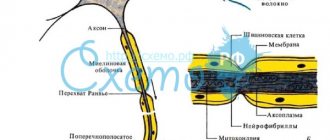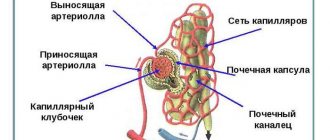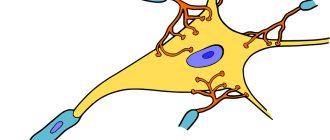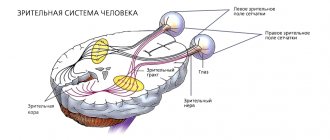ANALYZERS
ANALYZERS
- formations of the central and peripheral nervous system, which carry out the perception and analysis of information about phenomena occurring both in the environment surrounding the organism and within the organism itself. The term was introduced into physiological science by I. P. Pavlov. The doctrine of analyzers replaced the idealism and agnosticism that dominated the physiology of the sense organs. Initially, the physiology of the sense organs developed as a branch of the corresponding branches of physics (optics and acoustics) and, thanks to the efforts of R. Descartes, G. Helmholtz and others, accumulated many facts characterizing the physical properties of the organs of vision and hearing.
Pavlov's teaching about analyzers laid the foundations for a natural-scientific materialist understanding of the nature and mechanisms of sensations, learning processes and behavior. In accordance with Pavlov's classification, all analyzers are divided into two groups: external and internal. Analyzers An that carry out the analysis and synthesis of environmental phenomena are called external, or exteroceptive (see Exteroception). These include visual, auditory, olfactory, tactile and others. Analyzers that analyze phenomena occurring inside the body are called internal, or interoceptive (see Interoception). They provide information about the state of the gastrointestinal tract, cardiovascular system, lungs and other internal organs. One of the main internal analyzers is the motor analyzer (see). It informs the brain about the state of the muscular-articular system. Its receptors (see Proprioceptors) have a complex structure and are located in muscles, tendons and joints. The fact that the muscular system is not only an executive motor apparatus, but also a kind of sensory organ was known back in the early 19th century. Bell (S. Bell, 1826) wrote about this with complete certainty in his book “The Neuromotor Ring.” Subsequently, I.M. Sechenov (1863) showed that the “dark muscle sense” plays an important role in the mechanisms of movement regulation. The vestibular analyzer occupies an intermediate position between external and internal analyzers. It is located inside the body (inner ear), but is excited by external factors (acceleration and deceleration of rotational and linear movements).
Each analyzer consists of a peripheral (receptor) section, a conductive part and a cortical section. The peripheral section of the analyzer consists of specialized nerve endings - receptors (see), which convert certain types of energy (light, sound, heat) into the process of nervous excitation. Thanks to the specialization of receptors, the first analysis of external stimuli is carried out - decomposition of the whole into parts, distinguishing the nature and quality of signals. In this case, all types of external energy (light, sound, heat and cold, chemical and mechanical influences, etc.), transforming into a nervous process, enter the brain in the form of homogeneous signals. However, despite this, the brain accurately differentiates the informational meaning of these signals. Experimental data of Adrian (E. D. Adrian, 1931), Granit (R. Granit, 1957), Rushton (WAH Rushton, 1961), Barlow (N.V. Barlow, 1961), Hartline (H. Hartline, 1961) and others allow us to conclude that this is due to the fact that signals arising in the receptor part of the analyzer are encoded. The frequency and number of impulses propagating along the afferent nerves become essential in the mechanisms of information encoding. Since in each small period of time the nerve either transmits or does not transmit impulses, it is assumed that the transmission of information is carried out according to a binary code (impulse-pause). Bullock (T. H. Bullock, 1969) believes that, in addition to pulse-code communication, the transfer of information between neurons is also carried out in a non-pulse type, that is, thanks to specific electrotonic connections. However, in the analyzer system, the pulse-code type of information transmission is the main one.
In the mechanisms of information decoding, the peculiarities of the organization and functioning of the conductive parts of analyzers and their cortical projections acquire significant importance. The conductive part of the analyzer is represented not only by various nuclei of the thalamus and their projections to the corresponding areas of the cerebral cortex, but also by such formations as the reticular formation [Moruzzi, Megun (G. Moruzzi, HW Magoun), 1949], the structures of the limbic system [Nauta (V. Nauta), 1963] and the cerebellum [RS Snider, 1950]. The presence of these connections and the functional characteristics of the reticular formation and the cerebellum make it possible to classify them as structural elements of external and internal analyzers.
Subtle electrophysiological studies [Amassian (V. Amassian), 1950; Mountcastle (V.V. Mountcastle), 1964; R. A. Durinyan, 1965, and others] have established that the principle of extensive (expanding) projection of afferent systems as they ascend to higher structures of the brain is common to all levels of the central nervous system. This is most clearly expressed in thalamo-cortical projections. It has been established that the afferent signal, arriving even through one fiber, is transmitted to many neurons in the specific, associative and nonspecific nuclei of the thalamus, and they, in turn, switch each impulse to an even larger number of cortical neurons. In the cerebral cortex, where the highest analysis and synthesis of incoming information occurs, each analyzer has a specific localization. Thus, the visual analyzer is located mainly in the occipital region, the motor one - in the parietal region, the auditory one - in the temporal region of the cerebral cortex, and so on. The work of Adrian, Woolsey (S. N. Woolsey, 1943), Penfield (W. Penfield, 1954) and others made it possible to establish that some analyzers have several projection areas located in different parts of the cerebral cortex, and that we can talk about dual representation in the cerebral cortex of at least the somatic, auditory, visual and visceral analyzer.
In the cortical sections of the analyzers there are neurons that respond only to one sensory stimulation. These are, as a rule, specific projection neurons. Next to them are specific nerve cells that respond to various sensory stimuli, that is, they have multisensory convergence (see Cerebral cortex). There are especially many such neurons in the associative area of the cerebral cortex. Thanks to the convergence of excitations on the cortical neuron, interaction between many analyzers is possible. Based on the analysis of signals entering the brain from external and internal receptors, afferent synthesis (see) of adequate information is carried out with the subsequent formation of a behavior program, an apparatus for assessing the results of action (see Acceptor of action results).
Research in recent years has shown that the activity of analyzers is not limited to the analysis of external and internal information, but also includes the reverse influence of higher departments on the receptor and conductor parts of the analyzers. The sensitivity of the receptors (the perceiving part of the analyzers), as well as the functional state of the transmission relays (the conductive part of the analyzers) are determined by the descending influences of the cerebral cortex, which allows the body to actively select the most adequate sensory information at the moment from many stimuli. This is expressed by looking, listening to the animal, and so on, which is physiologically explained in the first case by a decrease in the threshold to visual stimuli, and in the second to auditory stimuli. To study analyzers, the method of conditioned reflexes, electrophysiological and morphological methods are used.
Bibliography:
Bullock T. X. Language of nerve cells, in the book: Systemic organization of physiology. functions, ed. V. V. Parina, p. 11, M., 1969; Granit R. Electrophysiological study of reception, trans. from English, M., 1957, bibliogr.; Guselnikov V.I. Electrophysiological study of analyzer systems in the phylogenesis of vertebrates, M., 1965, bibliogr.; Durinyan R. A. Central structure of afferent systems, L., 1965, bibliogr.; Mountcastle V. Some functional properties of the somatic afferent system, in the book: Theory of communication in sensory systems, trans. from English, ed. G. D. Smirnova, p. 185, M., 1964, bibliogr.; Mogendovich M. R. and Temkin I. B. Analyzers and internal organs, M., 1971, bibliogr.; Pavlov I.P. Complete works, vol. 3, book. 1 - 2, M.-L., 1951.
L. S. Gambaryan.
Physiological characteristics of human analyzers
Physiological characteristics of human analyzers - the ability of human organs to isolate and perceive information. Let's consider the main physiological characteristics of human analyzers:
The absolute threshold of sensitivity (lower and upper) is the minimum and maximum, respectively, value of the stimulus that can cause a sensation (in the second case, pain).
Intensity sensitivity range
Differential (discriminating) sensitivity is the minimum change in the intensity of the stimulus felt by a person.
The characteristics of the main human analyzers are given in Table 5.
Table 5
Physiological characteristics of human analyzers
| Analyzer | Absolute minimum threshold | |
| Units | Approximate value | |
| Visual | luxury | 4 10-9…10-3 (depending on adaptation) |
| Auditory | Pa | 2 10-5 (at 1000 Hz) |
| Tactile (Tactile) | mg/m2 | 3 … 300 |
| Flavoring | mg/l | 10 … 104 (depending on substance) |
| Olfactory | mg/l | 0.001 … 1 (depending on the substance) |
| Kinesthetic | Newton | No threshold sensation |
| Vestibular | m/s2 | 0,1 … 0,12 |
Based on psychophysiological studies, it has been established that the magnitude of differential sensitivity depends on the absolute magnitude of the stimulus.
An important physiological characteristic is the reaction time of the sense organs. Reaction time is the interval between the onset of the stimulus affecting the receptors and the arrival of the signal in the brain. Sense organs have different response times; these values are given in Table 6.
Table 6
Reaction time of human senses
| Analyzer type | Reaction time, sec |
| Tactile | 0,09 – 0,22 |
| Auditory | 0,12 – 0,18 |
| Visual | 0,15 – 0,22 |
| Olfactory | 0,31 – 0,39 |
| Temperature | 0,28 – 1,60 |
| Painful | 0,40 |
| Vestibular | 0,13 – 0,83 |
The transmission of a nerve impulse about a stimulus to the analyzing unit of the central nervous system or the peripheral nervous system occurs at a speed of 130 m/s. At the same time, different analyzers have different information throughput , shown in Table 7.
Table 7.
Characteristics of the throughput of the sense organs
| Perceived signal | Characteristic | Maximum transfer rate, Bit/s |
| Visual | Line length | 3,25 |
| Color | 3,1 | |
| Brightness | 3,3 | |
| Auditory | Volume | 2,3 |
| Pitch | 2,5 | |
| Flavoring | Salinity | 1,3 |
| Olfactory | Intensity | 1,53 |
| Tactile | Intensity | 2,0 |
| (tactile) | Duration | 2,3 |
| Location on the body | 2,8 |
Structure and properties of analyzers
Medical, biological and social problems of health.
Basic principles of ergonomics.
The role of biorhythms in ensuring human life.
Mental properties.
Mental states.
Mental processes.
Human psyche and life safety.
The importance of the nervous system in human life.
General understanding of metabolism and energy.
Characteristics of the main life safety analyzers.
Structure and properties of analyzers.
Plan
PHYSIOLOGICAL AND PSYCHOLOGICAL FEATURES OF THE HUMAN BODY
Lecture 4
Despite the presence of various hypotheses about the origin of life, everyone believes that the highest stage of development of all life on Earth is man.
Scientists have found that throughout the history of evolution, man has changed little anatomically and physiologically. The human body is a collection of bodily (somatic) and physiological systems: nervous, cardiovascular, circulatory, digestive, respiratory, sensory, musculoskeletal, etc. One of the most important human systems is the nervous system .
which connects all systems and parts of the body into a single whole.
The central nervous system takes part in receiving, processing and analyzing any information that comes from the external and internal environments .
When overloads occur on the human body, the nervous system determines the degree of their influence and forms protective and adaptive reactions. Anthropologists and physiologists note an extremely important physiological feature of the human body; his great potential and often untapped life opportunities.
A person receives a variety of information about the world around him, perceives all its various aspects with the help of the sensory system or sense organs.
The current stage of development of the physiology of the sense organs is associated with the names of such scientists as I.M. Sechenov (1829-1905) and I.P. Pavlov (1849-1936). I.P. Pavlov developed the work of I.M. Sechenov about brain reflexes, created the doctrine of analyzers as a set of neuroreceptor structures that ensure the perception of external stimuli, the transformation of their energy into the process of nervous excitation and its conduction into the central nervous system. According to I.P. Pavlov, any analyzer consists of three parts: peripheral (or receptor), conductive and central, where the analytical and synthetic processes of assessing the biological significance of the stimulus are completed
.
Analyzers are a set of interacting formations of the peripheral and central nervous systems that perceive and analyze information about phenomena that occur both in the environment and within the body itself. The structure of the analyzer is a receptor (perceiving formation), sensitive neurons, a section of the cerebral cortex.
In modern physiology, eight analyzers are distinguished - motor, visual, auditory, gustatory, olfactory, cutaneous, vestibular and visceral. However, in the system of human interaction with environmental objects, the main ones in identifying danger are the visual, auditory and skin analyzers. Others perform an auxiliary or complementary function. At the same time, it is also necessary to take into account the fact that today there are a number of dangerous factors (ionizing radiation, electromagnetic fields, ultrasound, infrared radiation) that have an extremely negative physical effect on the human body, but there are no appropriate natural analyzers for their perception.
All analyzers are structurally the same. They have devices on their periphery that perceive stimuli - receptors , in which the energy of stimulation is converted into the process of excitation. From receptors along sensory neurons and synapses (contacts between nerve cells), impulses enter the central nervous system.
There are the following main types of receptors : mechanoreceptors , which perceive mechanical energy, these include receptors: auditory, vestibular, motor, and partially visceral sensitivity ; chemoreceptors - olfactory, gustatory ;
thermoreceptors -
skin analyzer receptors ; photoreceptors - visual analyzer
and other types. Each receptor selects its own adequate stimulus from the multitude of stimuli from the external and internal environment. This explains the high sensitivity of the receptors.
All analyzers, due to their similar structure, have common psychophysiological properties - extremely high sensitivity to adequate stimuli, the presence of an absolute differential and operational limit of sensitivity to a stimulus, the ability to adapt, train, the ability to maintain a sensation for a certain time after the cessation of the stimulus, to remain in the next interaction one after another. to others.
The absolute sensitivity limit has upper and lower levels. The lower absolute limit of sensitivity is the minimum value of the stimulus that causes sensitivity. Upper absolute limit
-
the maximum permissible value of a stimulus that does not cause pain in a person.
Differential sensitivity is determined by the smallest magnitude of the stimulus, which makes it possible to sense its change. This position was first introduced by the German physiologist A. Weber and quantitatively described by the German physicist G. Fechner. Basic psychophysical law of Weber-Fechner physiology : the intensity of sensations is proportional to the logarithm of the intensity of the stimulus:
S
=
C
log
I
,
where S
- intensity (or strength) of sensation;
I
— size of the current stimulus;
WITH
— proportionality coefficient.
Adaptability —
this is the ability to adapt the level of one’s sensitivity to stimuli.








